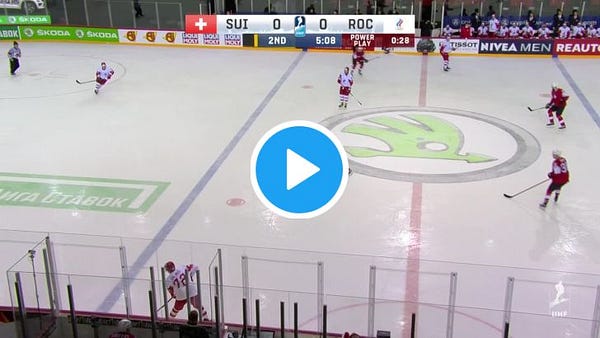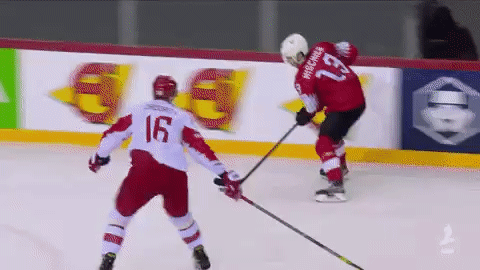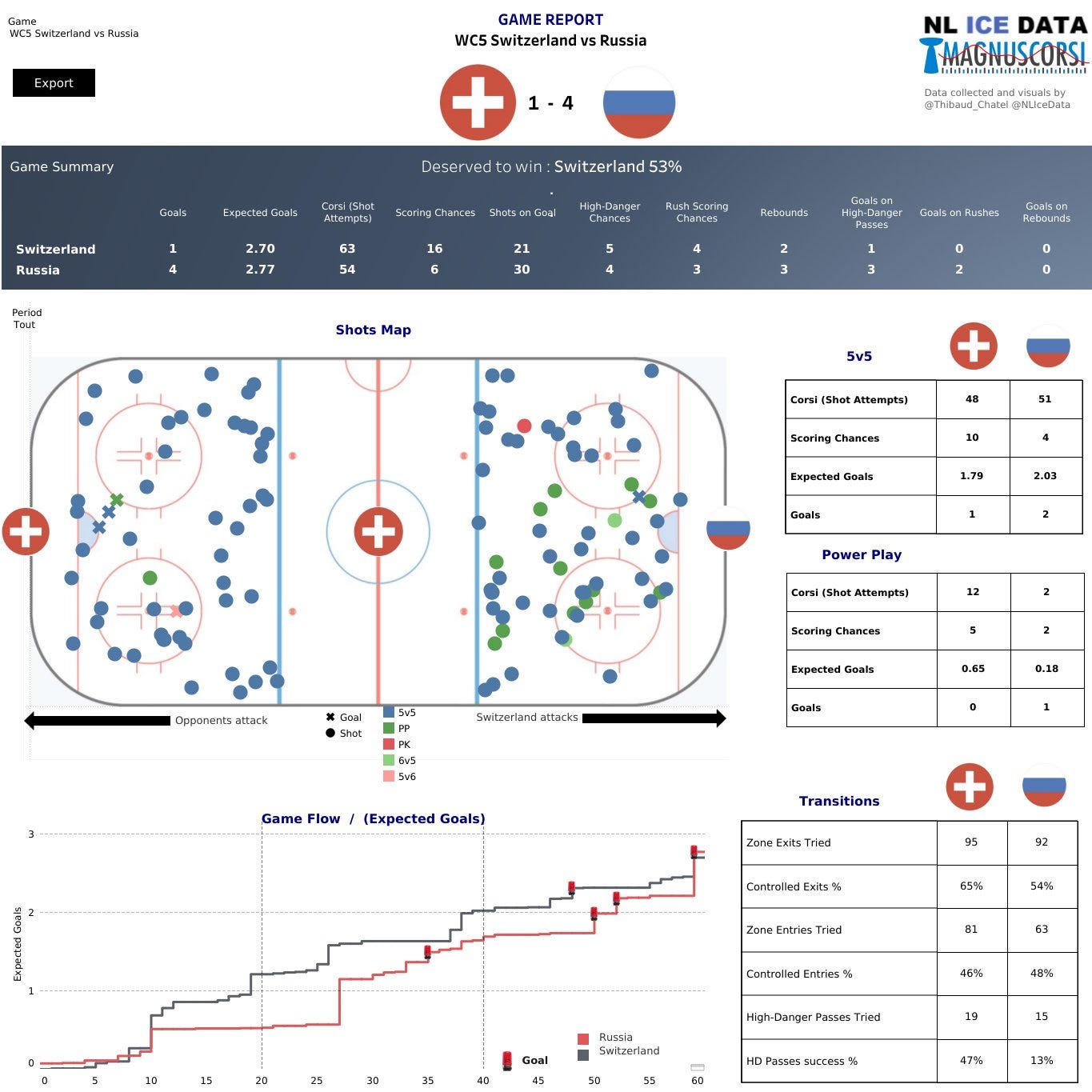In an interview for HeShootsHeScores, a lucid Joël Vermin talked about a good and close game, chances that the Swiss players couldn’t finish and details. Ambühl and Kurashev had similar opinions in 20Minuten. In an interview for RTS and 20Minuten, Patrick Fischer talked about a good performance against Russia, an opponent that was certainly not better and that was efficient in scoring on the few mistakes Switzerland made.
If we except Russia’s empty net goal, the Swiss did indeed finish ahead in expected goals, with 2.71 to 2.20, even though Russia was slightly ahead at 5v5. They also had more scoring chances (16 to 6) and only scored once on 63 shot attempts.
Coach’s adjustment for this game
Since the beginning of the tournament, Fischer has usually made adjustments between games with both his offensive lines and defensive pairs. For this game against Russia, he dressed Frick for his first game and put him on the third pair with Heldner (they replaced the Moser-Untersander pair) and Rod came in for Mottet as the 13th forward.
First period
Both teams came out strong in this game, trying to put pressure on the opponent’s defence.
After 12 seconds, as Berra was going to freeze the puck after a rebound, Slepyshev was able to shot the puck before the Swiss goalie could make his move. The puck hit the post.
It took nearly 5 minutes and a great play from Simion in the neutral zone, beating two forecheckers, and a pass to Hofmann for a clean zone entry to establish a first sequence in the offensive zone. The Swiss generated three shot attempts as well as a missed puck from Hofmann in the slot. On the next shift from the Swiss’ first line and a coordinated forecheck effort by both Ambühl and Hischier, the Swiss players were able to recover the puck from Nesterov.
After 8 minutes, another example of Hofmann’s great play on transition. As he recovers the puck in his defensive zone, we can see him draw two forecheckers, wait for Corvi to be available for the clean zone exit and feed him with a flipped backhand pass. Diaz immediately recognizes an opportunity and support the attack. On the zone entry, Corvi makes a little delay, forces the opposite defencemen to stop and dishes the puck to Diaz coming with speed for a nice walk-in play and a dangerous shot at the hash marks. A great sequence with a line that has constantly been dangerous (on transition) throughout the tournament.


Two minutes later, with the whole fourth line deep down in the offensive zone, a missed pass from Herzog to Geisser intercepted by Burdasov lead to a rush against with a 4-on-2. On a delay after the zone entry, Burdasov finds Galimov in the slot but Berra makes the save. On the rebound, and from behind the goal line, Morozov tries to find Berra’s back but can’t complete. As you can see in the game flow below, this was Russia’s best sequence in the first period, which started with a small mistake in the offensive zone. The remaining of the period saw Switzerland creating most chances.
One the puck recovered by Switzerland right after this sequence from Russia, Herzog was able to draw a penalty on his zone entry (and add another one for the 4th line during this tournament), drive the net and take a shot on is backhand. Bertschy got the rebound, but his shot was blocked and Herzog was able to find Scherwey near the faceoff dot for another chance. In terms of xG, this sequence made up for Herzog’s previous mistake at the beginning of his shift.
On the power-play that followed, the Swiss’ top PP-unit (Alatalo - Hischier - Meier - Kurashev - Corvi) nearly stayed on the ice for the whole two minutes as they were able to win the faceoff and maintain the possession of puck in the offensive zone for nearly two minutes. How? Thanks to the quality of execution, by varying the plays or by changing positions, they make it complicated to defend against. Kurashev hit a post and Meier was unable to score on a difficult angle but with an open net.
It probably explains why Sweden and Slovakia were as aggressive as they were on the penalty-kill and especially on the forecheck and when trying to stop Swiss players entering the offensive zone (similar to what the Carolina Hurricanes do in the NHL, as described here by Shayna Goldman and Sara Civian). They didn’t want the Swiss team to get set in formation. If we don’t expect the Swiss’ power-play to maintain its insane efficiency (45% before this game), it regularly shows why it’s among the best during this tournament.
Another interesting play from the first period is again offered by the Hofmann’s line. As Hofmann sees no option in the neutral zone, instead of reaching the red line and dumping the puck, he regroups, passes the puck to Geisser, who directly passes it to Diaz to beat the first Russian forechecker. Then, Diaz reverses the play to find Hofmann on his left wing and beat the second Russian forechecker. Hofmann connects with Simion who’s able to gain the offensive zone with speed and take a good shot on the rush. On Simion’s forecheck right after his shot, Corvi recovers the puck and finds Hofmann, whose shot from the high slot is blocked.


Less than one minute before the end of the period, Heldner found Hischier on a quick breakout. As he enters the zone, he sees Ambühl driving the net and is able to feed him on a nice backhand pass to the slot. Unfortunately, Samonov is able to make a clean save. A few seconds later, on an entry and great play on transition from Hofmann, Corvi finds Simion for a one-timer with a pass from the goal line.
If Russia had two good chances in this first period, Switzerland was the best team on the ice during this period and especially in the second part. Unfortunately, they weren’t able to score.
After 20 minutes: 1.21 xG for Switzerland, 0.52 xG for Russia
Second period
In the first 5 minutes the period, the Swiss team globally controlled the puck but wasn’t able to generate many quality chances. They still generated a penalty when Geisser drew a penalty on a zone exit. On the power-play that followed, Meier was able to connect with Hischier, with a pass from behind the net, but Hischier missed the net.
Than, Russia got its best chance since the beginning of the game, with a shot worth 0.54xG. On a non-dangerous chance on the rush, Berra let a rebound behind the goal line that Slepyshev was able to recover. He tried a wrap-around on the other side of the net but fortunately for the Swiss team, Siegenthaler aniticipated the play and was able to block the shot.
Outside of a few chances off the rush and some point shots, not much happened before Loeffel’s penalty at 33:19. Under pressure despite a faceoff win from Hischier in the defensive zone, Loeffel put the puck over the glass for the Swiss’ lone penalty of the game.
On the power-play, the Russians managed to get two pucks on net. The first one with a pass from below the goal line for Tolchinski in the slot where Berra made the stop. And the second one, where he couldn’t as he faced Burdasov. The Russian came down the right wing, was able to get passed Frick, a bit too aggressive and nearly stopped at the blueline, and drove the net to beat Berra.


In the last three minutes of the period, the Swiss managed to get their best chances of the period and the Russians to hit the iron on a puck recovered by Voronkov on a rebound from Berra.
On a pass from Vermin to Ambühl that eliminates three opponents, Ambühl is then able to beat his defender and drive the net from below the goal line. Unfortunately, he missed the net. The second chance was on another great rush from Hofmann where he beats his opponent on a one-on-one, gets a shot that is blocked right after the zone entry, is able to recover the puck below the goal line and pass the puck to Herzog in the blue paint. Herzog misses a bit his shot but the puck is deflected by the Russian defenceman on the post.
After 40 minutes: 2.02 xG for Switzerland, 1.64 xG for Russia
Third period
The third period started a bit flat for both teams as you could feel the stakes getting higher every minutes. Eventually, each teams got some dangerous sequences. And suddenly, Ambühl had an inspiration, throwing the puck at center ice where Nico Hischier one-timed it to tie the game.


But the story of the game is that Russia scored on their big chances. At the 50th, Karnaukhov redirected a high-danger pass in front of the net as Geisser had just been called for a penalty maybe taking the Swiss players attention away from the puck for a second.
Then Tolchinski went on a break away to beat Berra with a perfect move.
After 60 minutes: 2.70 xG for Switzerland, 2.21 xG for Russia (or 2.77 with the empty-net goal)
By the numbers
Despite having been maybe more challenged like never before in this Worlds, the Swiss had the best probabilities of winning here, with a 2.70 to 2.21xG advantage before the empty net. However, at 5v5, the Russians finished with 2.03xG to 1.79 thanks to a handful of high danger chances, including their two goals at even-strength.
In a tight game at 5v5, Switzerland was slightly more dangerous on Walk-ins, high-danger passes and rushes but Russia had 3 big rebounds worth 0.63xG though they didn’t capitalize on them.
Transition
One department where Switzerland had more trouble than ever before in this tournament was in preventing Russia to enter the offensive zone. Though the Russians ended up with a 48% of controlled entries, which is good, they added to that a gigantic 43% of recovered dumps! Czech, Sweden or Slovakia only recovered respectively 14%, 24% and 17%. The speed and physicality of the Russians was a new challenge here for the Swiss.
Goaltenders
First hiccup in 3 starts for Reto Berra as he allowed 0.79 goals above expectations tonight, with an okay 69% shot control. He was beaten twice on Russians forwards walking in his slot to take a perfect shot. But Berra made no miracle here.
Offensive contribution
Hofmann tried a lot… As usual, though with maybe less success than before for his line in terms of finishing. But with a 6 for 6 on exits, all controlled, and an 8 for 10 on entries, plus 2 high danger passes leading to a shot, he turned into a playmaker for 60 minutes. Herzog was re-established in the line up and his impact on transition was clear. Hats off to Alatalo and Corvi for their 7 shot assits.
We were a bit doubtful of the Ambühl-Hischier-Kurashev line but they seemed to have found their rhythm here. Hischier retrieved pucks lower to help build plays and all three players took their responsibilities in terms of shooting, which goes a bit against their own true natures. They all end with 6 attempts and 1.25xG combined, almost half the team’s total production. And they have a beauty of a goal to brag about.
You can also follow us on our Twitter pages here and here or subscribe to our newsletter below if you don’t want to miss our coming articles.
Find more statistics tracked by Thibaud on his Tableau’s page here: https://public.tableau.com/profile/thibaud.chatel#!/vizhome/WorldChampionship2021/GameReport
















